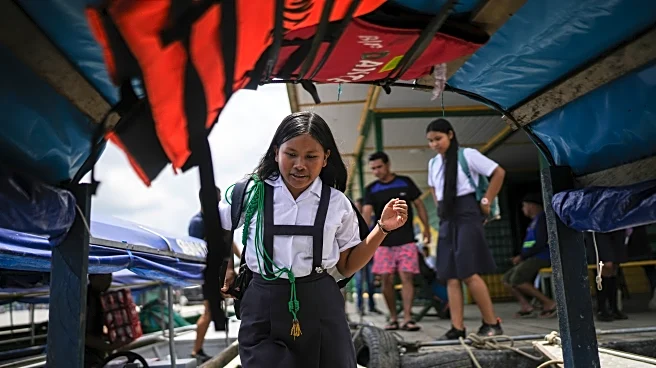Rapid Read • 9 min read
Santa Rosa Island, located in the Amazon River, is currently at the center of a territorial dispute between Peru and Colombia. Despite the diplomatic tensions, daily life for the island's approximately 3,000 residents remains largely unaffected. The island, claimed by Peru based on century-old treaties, is contested by Colombia, which argues the island had not emerged at the time of the treaties. Residents, identifying as Peruvians, coexist peacefully with their Colombian and Brazilian neighbors, relying on these countries for essential services. Salvador Mitidieri, a boat operator, plays a crucial role in this community by ferrying students from Tabatinga, Brazil, to the island's sole primary school in Santa Rosa, Peru. Classes are conducted in Spanish, and the students are either Peruvian or born to Peruvian parents in Brazil. Despite the lack of infrastructure like running water and sewage systems, the community maintains a harmonious relationship across borders.
AD
The situation on Santa Rosa Island highlights the complexities of territorial disputes and their impact on local communities. While diplomatic exchanges continue between Peru and Colombia, the residents of Santa Rosa demonstrate resilience and adaptability, maintaining peaceful relations with neighboring countries. This scenario underscores the importance of cross-border cooperation in regions where geopolitical tensions exist. The island's reliance on Colombia and Brazil for healthcare and other services illustrates the interconnectedness of these communities, which could serve as a model for resolving similar disputes elsewhere. The ongoing situation also raises questions about the effectiveness of historical treaties in addressing modern territorial claims.
As the territorial dispute persists, the future of Santa Rosa Island remains uncertain. Potential resolutions could involve diplomatic negotiations between Peru and Colombia, possibly mediated by international organizations. The residents' continued reliance on neighboring countries for essential services may prompt discussions on formalizing cross-border agreements to ensure stability and access to resources. Additionally, the educational opportunities for students commuting from Brazil to Peru may influence future policy decisions regarding infrastructure development and investment in the region. Stakeholders, including local governments and international bodies, may need to address the long-term implications of the dispute on the island's residents.
The situation on Santa Rosa Island offers insights into the broader implications of territorial disputes on cultural and social dynamics. The peaceful coexistence of residents from different national backgrounds highlights the potential for cultural integration and mutual understanding in disputed regions. This case also raises ethical considerations regarding the rights of indigenous and local populations in territorial conflicts. The lack of infrastructure on the island points to broader issues of development and resource allocation in remote areas, which may require attention from policymakers and international aid organizations.
AD
More Stories You Might Enjoy











